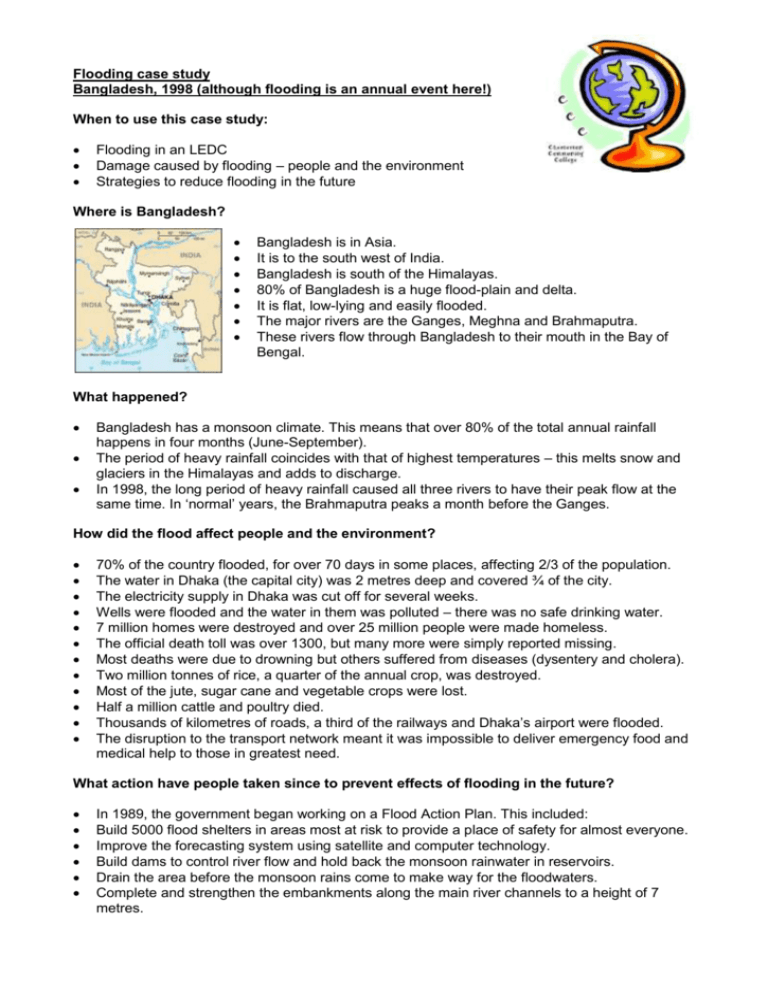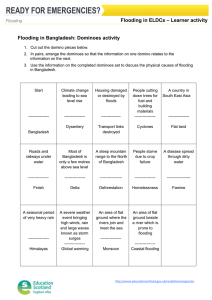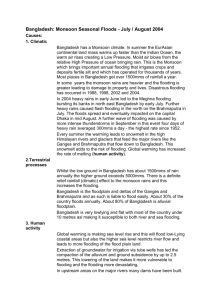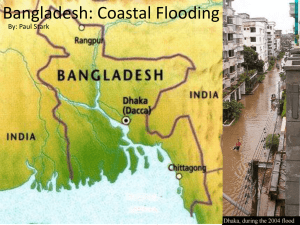bangladesh-flooding-case-study
advertisement

Flooding case study Bangladesh, 1998 (although flooding is an annual event here!) When to use this case study: Flooding in an LEDC Damage caused by flooding – people and the environment Strategies to reduce flooding in the future Where is Bangladesh? Bangladesh is in Asia. It is to the south west of India. Bangladesh is south of the Himalayas. 80% of Bangladesh is a huge flood-plain and delta. It is flat, low-lying and easily flooded. The major rivers are the Ganges, Meghna and Brahmaputra. These rivers flow through Bangladesh to their mouth in the Bay of Bengal. What happened? Bangladesh has a monsoon climate. This means that over 80% of the total annual rainfall happens in four months (June-September). The period of heavy rainfall coincides with that of highest temperatures – this melts snow and glaciers in the Himalayas and adds to discharge. In 1998, the long period of heavy rainfall caused all three rivers to have their peak flow at the same time. In ‘normal’ years, the Brahmaputra peaks a month before the Ganges. How did the flood affect people and the environment? 70% of the country flooded, for over 70 days in some places, affecting 2/3 of the population. The water in Dhaka (the capital city) was 2 metres deep and covered ¾ of the city. The electricity supply in Dhaka was cut off for several weeks. Wells were flooded and the water in them was polluted – there was no safe drinking water. 7 million homes were destroyed and over 25 million people were made homeless. The official death toll was over 1300, but many more were simply reported missing. Most deaths were due to drowning but others suffered from diseases (dysentery and cholera). Two million tonnes of rice, a quarter of the annual crop, was destroyed. Most of the jute, sugar cane and vegetable crops were lost. Half a million cattle and poultry died. Thousands of kilometres of roads, a third of the railways and Dhaka’s airport were flooded. The disruption to the transport network meant it was impossible to deliver emergency food and medical help to those in greatest need. What action have people taken since to prevent effects of flooding in the future? In 1989, the government began working on a Flood Action Plan. This included: Build 5000 flood shelters in areas most at risk to provide a place of safety for almost everyone. Improve the forecasting system using satellite and computer technology. Build dams to control river flow and hold back the monsoon rainwater in reservoirs. Drain the area before the monsoon rains come to make way for the floodwaters. Complete and strengthen the embankments along the main river channels to a height of 7 metres.











